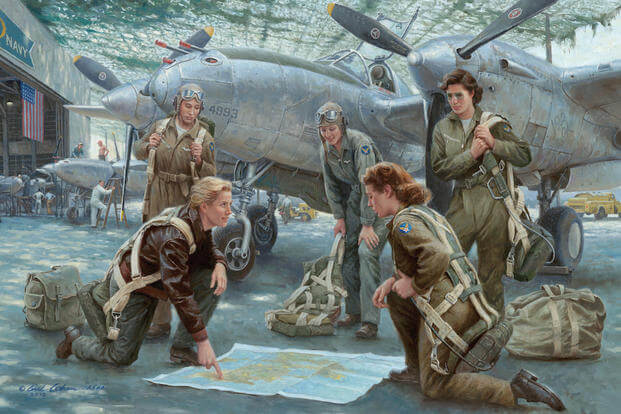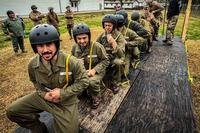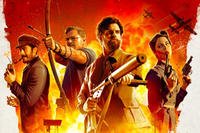During World War II, Women Airforce Service Pilots (a/k/a WASPs) played a critical role in the deployment of airplanes, flying more than nine million miles in 72 different aircraft—115,000 pilot hours—for the Ferrying Division, Air Transport Command. Sarah Byrn Rickman chronicles the history in WASP of the Ferry Command: Women Pilots, Uncommon Deeds (available now from the University of North Texas Press) and shares some stories from the pilots in the list below.

Barbara Donahue was the second woman to fly the World War II fighter plane, the P-39 Airacobra.
1) P-39 Gives Bus An Eyeful
Enroute to Great Falls, Montana, from the Bell Aircraft factory in Buffalo, New York, Barbara Donahue’s P-39 developed a problem that she knew could only be fixed on the ground. The WASP ferry pilot checked her surroundings and saw no optimum place to land so, since she was over sparsely populated North Dakota, she opted to set the airplane down on a deserted stretch of highway.
As she flew her final approach, she overtook a bus.
Both the bus driver and his passengers looked up to see a P-39 bearing down on and then soaring over the top of them.
The plane landed several hundred feet down the highway and rolled to a stop. As the bus pulled up behind the aircraft — now blocking both lanes — all aboard watched as out stepped a tall, willowy woman pilot.
The driver leaned out the window and shouted, “What’s the matter, lady, get tired of flying?”

Teresa James flew the 10,000th Republic Aviation’s P-47 Thunderbolt from Long Island to the docks at Newark, September 1944. The plane was christened “Ten Grand.”
2) Ever Flown a P-51?
Teresa James left Farmingdale, NY, and the Republic Aircraft factory one morning in 1944 flying a P-47 destined for the modification plant in Evansville, IN. “I thought I’d be back by nightfall. They promised me a P-47 back to Farmingdale, so I didn’t take my B-4 bag. I did have the foresight to put a lipstick in my shirt pocket.”
Four weeks later, Teresa returned to Farmingdale. She had covered 11,000 miles, seventeen states, in seven airplanes in the interim. She looked awful. Her uniform trousers were rump sprung and knee sprung — “Like I’d had a pair of cantaloupes in the legs.
“Thanks to the rainy weather down south, my mud-caked shoes were unrecognizable. The humidity was so high, my socks and underwear wouldn’t dry overnight and I had to put them back on wet every morning. Worst of all, I didn’t have my uniform jacket, so they wouldn’t let me in the Officers Clubs to eat. I had to be content with sandwiches and stuff from the Operations canteens.”
The good news came when the Operations officer in Long Beach asked, “Ever flown a P-51?”
“No” said Teresa.
“That one over there has to go to Fort Myers, Florida,” the officer said. “Here are the tech orders. Sit in the cockpit and get familiar, then check yourself out.”

Jo Myers bummed a ride in the ‘rumble seat” of her boss’ twin-engine A-20 attack plane.
3) Riding in the Rumble Seat
Romulus ferry pilot Jo Myers was going to Washington D.C. to see her sister. “I bummed a ride down to Wilmington, but I still needed to get to D.C. Nancy Love — our boss, the chief of the women ferry pilots — was there in her plane. It was a twin-engine with one-seat, but with a rear compartment for a gunner. [Nancy’s utility plane was at A-20, twin-engine attack plane.]
“She asked if I wanted to go with her. I said, ‘Sure.’ She put me in the gunner’s seat, flew me down to Washington and then drove me out to my sister’s house.”

Before Delphine Bohn flew the hot P-38, she spent time flying an “air-conditioned” (open cockpit) PT-17 Stearman.
4) Your Position Please? “I Don’t Know”
Delphine Bohn, commander of the WASP ferrying squadron at Love Field, Dallas, had a surprise waiting for her when she delivered at P-38 to Fresno, California.
“Crossing the Tehachapi Mountains, the last checkpoint before letdown, I saw Fresno’s field and runways despite its highly touted camouflage. On the radio I identified my aircraft and myself by the proper wartime code for entry into that vulnerable and highly skittish West Coast area. When I lifted my head out of the cockpit, the field had vanished! No airport, no runway.
“Already I was down to pattern altitude. I should long since have seen the field and contacted the tower. Finally the tower called. ‘Your position, please?’
“In a hesitant voice I answered, ‘I don’t know.’
“I was informed that I was on final, to prepare for touchdown. Then, only because my wheels rolled on hard surface, could I be certain I was no longer airborne. At end of rollout, not one but three jeeps awaited me.
“I eased in after the one with the ‘Follow Me’ sign. The other two jeeps, exceedingly well manned, eased in behind my P-38, single file. At the line, I shut everything down. My escorts stopped surprisingly close, one on each side. Several enormous, very well armed males—military police, for that was their obvious capacity—stepped down from each. They formed a line to await my descent from the P-38.
“With visibly shaking knees, I managed to climb down. Immediately, it was made crystal clear to me that I had used the wrong wartime identification code. I’d used the code that alerted the entire West Coast to an enemy invasion.”

When strapped in to a P-51, Jean Landis “felt like part of the plane, like a bird and those were my wings.”
5) I Did Everything Properly, Sir!”
Jean Landis drew her dream plane, the P-51, for her first flight at pursuit school. She completed her aerial maneuvers, descended, lowered the gear and prepared to land. A red warning light indicated the gear was not locked. The tower told her to go back upstairs and perform the prescribed emergency measures. Several times, she dived the aircraft and pulled up quickly trying to lock the gear in place. The red light remained on.
“Come in softly, gently touch the wheels to the runway,” the tower advised. “If they don’t hold, give her the gun, get to altitude and continue circling.” As Jean neared the end of the runway, she noted the line of fire trucks and the hash wagon standing by. The wheels touched … and held. She taxied in.
“Well what did you do wrong?” her instructor yelled.
“I think I did everything properly, Sir!”
“He got in and took off. The last thing I saw, he was all over the sky, diving and pulling up sharply, trying to get the wheels down and locked and the red light to go off. I wanted to shout, ‘I told you so.’”

On the way to pursuit school and flying that P-40, Betty Whitlow first mastered this PT-19 trainer aircraft.
6) Those Are the Brakes!
Dallas ferry pilot Betty Whitlow had vivid memories of her very first pursuit delivery — a P-40.
“It was a beautiful experience, until I touched down on the runway at the Oakland Naval Air Station. I was cleared by the tower and made a beautiful landing. A split second later, a little plane crossed the runway, right in my path.
“P-40s are tail draggers, so I could not see anything in front of me. I’m going 100 to 120 miles an hour. And there are these two fellows in this little plane. I got so close I could see their expressions of shock.
“I put on the brakes. Nothing else I could do. At that same instant, the tower comes on the radio and says, ‘P-40 on the runway …’ Well, I put them on a little too hard, just hard enough that the plane sort of eased up and then nosed over. It bent the propeller!
“This plane was supposed to go out to the Pacific that night. I was furious! I sat there fuming. I turned off the switches, and I still was fuming. The tower had cleared me to land, and I made a beautiful landing. I don’t know why he was there, but the damage was done. I contacted my base. They never blamed me for anything.
“It was my first ferry trip in a pursuit! That’s what infuriated me so. And I was landing at a Naval Air Station!

Jane Straughan flew them all, from primary trainers to the pursuits. Here she climbs into an AT-6 (advanced trainer) Texan.
7) But We’re MARRIED!
“I ran into my ferry-pilot-husband, Al, in North Carolina,” Wilmington ferry pilot Jane Straughan recalls. “Well, of course, we were delighted. There were bunches of ferry pilots coming in and going to the hotel. Al took the parachutes and our B-4 bags and I went to register. This very nice clerk behind the counter, an older man, asked me if I would step aside. He advised me that they didn’t like to register male and female pilots in the same room.
“I said, ‘Well, this is my husband.’
“‘But we prefer that you do not register.’
“I said, ‘We are married!’ I was getting huffed.
“Finally I got out my orders and Al’s orders to prove our last names were the same. He was very apologetic, because in the meantime he had explained to me about venereal diseases. I still was huffed, but then I thought, ‘This is funny.’ When Al came over, of course, he thought it was funny. He didn’t see why I was huffed at all.
“Well, there were two older women getting on the elevator. I guess they had seen Al come over to me, and we got on the same elevator. One of them said, without lowering her voice, ‘Thank god that’s not my daughter over there. You don’t know what they’ll be doing now.’
“I said, ‘Al, gee, this is really nice because now we’ve got to live up to our expectations tonight.’”

Marion Schorr (right) with two other Romulus, Michigan, ferry pilots Marianne Beard and Janet Zuchowski.
8) I Saw the Face of God!
“I ferried a lot of AT-16s from Montreal down to Newark,” Romulus ferry pilot Marion Schorr recalled. “Two lieutenants and I were on this trip.
“I had a picture-perfect view of the Hudson River when the ceiling started to get lower and lower. When the guys dove down low, I knew they were going to fly right down the Hudson River. “I wasn’t familiar with that area and was afraid there might be wires across the river, so I went upstairs. When I knew it was about time to let down, I started my descent through the clouds.
“Suddenly I saw this huge face in front of me. It scared the daylights out of me. All I could think was—it was God! This big, white face! My instinct was to peel off to the right. I did. I turned right, real sharp, and climbed. I climbed back up on top thinking, “where am I and what was that?”
“The Statue of Liberty is a little bitty dot on our charts — no bigger than a pinhead. It says “Statue of Liberty” in small print.
“That’s where I had been!
“The torch is in her right hand. Instinctively I had “peeled off” to the right. If I had turned left, for sure, I would have hit the torch. If I’d gone into the Statue of Liberty, I think she’d have won.”

Sylvia Dahmes: “The snow was so bad, we flew along the railroad track, so low that I swear we had to climb when the train came along.”
9) We Quit Flying Hours Ago!
Sylvia Dahmes recalls a group of WASP from Romulus taking PT-26s to Calgary, Canada, in the dead of winter. “We took off in the snow and soon got into more of it over southern Canada, so we landed in Windsor near Detroit.
“The next day, our destination was Winnipeg and visibility was so bad, we flew along the railroad track, so low that I swear we had to climb when the train came along. We knew we needed to land.
“Our alternate airport was Medicine Hat, a training base for British cadets. Tat’s where we went. Now the British cadets were not allowed to speak to women when they were in training, so we were a definite inconvenience. We sat in the Commanding Officer’s office until they served the cadets their dinner—several hundred of them. After that they cleaned out the dining room, took us in and fed us Then the question arose of where would we sleep. Finally, an officer escorted us to the emergency ward in the hospital. That would be our sleeping quarters.
“As our escort said goodnight, he looked at us, shook his head and said, ‘we quit flying hours ago.’”

Inez Woodward’s emergency landing plunked her right in the middle of the War Games Exercise in Lebanon, Tennessee.
10) I’ll Just Sleep in the Ready Room
Over Tennessee, Inez Woodward’s tiny, one-seat PQ-14 started leaking oil. “It was a plywood plane covered with dope — a flying coffin. As far as I was concerned, it was a torch! I decided not to try for Nashville and landed in Lebanon, in the middle of War Games — the Red versus the Blue armies.
“There were no hotel rooms. ‘I’ll just sleep in the Ready Room,’ I told the officer-in-charge.
“ ‘Oh, you can’t do that. There’s too many men around here.’ He paused.
“I waited.
“ ‘Excuse me a minute,’ he said. When he came back he said, ‘I have a place for you to sleep, but I’m going to take you to dinner first.’
“After dinner he said, ‘Now, you go use the restroom here and do whatever you’re going to do because you’re not going to have a restroom until tomorrow morning when I pick you up.’
“I had no luggage—a toothbrush was about all—because I was flying a one-place airplane.
“We went to this house and opened the door. Not a soul in sight. We went up on the landing to a winding staircase. There was a door tucked away. He pushed it open. ‘This is your room, he said. ‘Lock the door. Do not come out until I come and knock on your door tomorrow and give you my name.’
“It was an oversized closet, but the bed was clean. I was asleep in no time. But all night long I heard men coming and going up and down the stairs. A couple of drunks even bounced off my door, apparently trying to make it around that corner in the hall.
“Slowly it dawned on my thick skull where I was. — But I was there, so what about it!
“The next morning, the officer took me to breakfast then I called Berry Field in Nashville and asked them to let me have a straight-in approach. When I got there, they had to rip out the gas lines as well as the oil lines and then rebuild them.
“I enjoyed my stay at Berry Field.”
Photos courtesy Texas Woman’s University — the WASP Archives, and from author Sarah Byrn Rickman’s personal collection.





